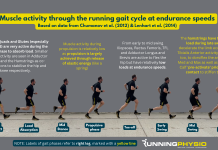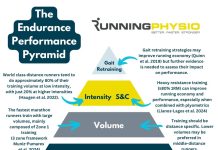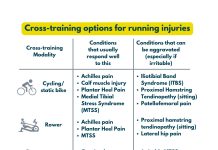Our articles are not designed to replace medical advice. If you have an injury we recommend seeing a qualified health professional. To book an appointment with Tom Goom (AKA ‘The Running Physio’) visit our clinic page. We offer both in-person assessments and online consultations.
B.J. Lehecka, DPT, Assistant Professor at Wichita State University Department of Physical Therapy has kindly written us a unique guest blog. It’s the only article I’ve ever read that features ancient Greek philosophers, gait re-education and Jay-Z! He is a lover of running and music and today tells us how best to combine the two! Follow B.J. on Twitter via @WichitaPT.
Perhaps the most famous fresco by Italian Renaissance artist Raphael is The School of Athens, housed in the Apostolic Palace in the Vatican.
Picture source
Skillfully placed in the center of the painting are two of the most influential thinkers of the Western world, Plato and Aristotle. Aristotle is on the right, wearing sandals, clothed in earthy blue and brown (suggestive of water and dirt, elements constrained by gravity), pointing his palm toward the ground, and carrying a book of ethics. His philosophy was that the only reality is the one we can see and experience by sight and touch. In contrast, on the left stands Aristotle’s teacher, Plato. This seemingly barefoot runner is wearing grey and red colors (suggestive of air and fire, elements unconstrained by gravity), pointing towards the sky, and carrying a book about mathematics and order and beauty.
Sometimes we need an Aristotle, a scientist grounded in what we can see and feel, somebody to tell us about ground reaction forces, analyze running mechanics, and describe the electromyographic activity of gluteal muscles during a myriad of exercises. But sometimes we need a Plato, or even a Raphael, an artist, a composer, somebody or something that motivates us from another place. We can arrange the intellectual furniture all day, but sometimes we need a DJ.
Music has a way of bypassing the intellect and connecting at a different level. That’s why television dramas and movies play songs during meaningful monologues. The Verve in Bittersweet Symphony sings the lyric “I need to hear some sounds that recognize the pain in me.” We may not be able to see or feel it, but music has the ability to stir the soul, resonate with our thoughts, minister to our emotions, and fuel our movements.
Here’s where the scientist and artist become excellent dance partners.
The research behind music and running is fascinating. Studies on humans, nonhuman primates, and music propose that “there appear to be motivational ties to music that are uniquely human” and we may be “candidates for music-specific adaptations.” (McDermott, 2007; McDermott, 2007) And multiple running studies support this. One study of treadmill running by elite triathletes found that time to exhaustion was nearly 20% longer when running in time to music compared to no music. (Terry, 2012) The athletes were able to run an average of 8 minutes and 33 seconds with music versus 7 minutes and 11 seconds with no music, both at 110% of their blood lactate threshold velocity. Music has also been shown to improve performance during 400-meter sprinting, cycle ergometry, and treadmill walking. (Simpson, 2006; Anshel, 1978; Karageorghis, 2009)
Music moves us, and it makes us move significantly longer, faster, with more positive moods, with lower ratings of perceived exertion, and the ability to sing duets with Bono, Jay-Z, Sara Bareilles, and Pharrell Williams.
We’ve also learned that increasing running cadence by 5-10% is associated with multiple benefits:
- The hip and knee absorb significantly less mechanical energy. (Heiderscheit, 2011)
- Peak hip adduction and internal rotation moments decrease. (Heiderscheit, 2011)
- Center of mass vertical excursion, braking impulse, and peak knee flexion angle all significantly decrease. (Heiderscheit, 2011)
- Patellofemoral joint force is reduced by 14%. (Lenhart, 2014)
- Gluteus medius and maximus activity increases during the late swing phase. (Chumanov, 2012)
- Pressure and force variables in the heel and metatarsal regions are reduced by 565 body weights*second (BW*s) and 140-170 BW*s per mile, respectively. (Wellenkotter, 2014)
Moreover, tailored music may be the ideal way to retrain running cadence. One study concluded that running to motivational music with a prominent and consistent beat matched to the runner’s cadence will likely produce optimal effects. (Bood, 2013) The i-Metronome app or similar apps will allow you to tap a button to determine the beats or steps per minute of a song or cadence, respectively. There are also multiple websites with lists of song suggestions and their corresponding cadences, but here’s an eclectic sampling to get you started:
Count your running cadence by multiplying by two the number of times your right foot contacts the ground during a given minute of running, then find songs that match your desired cadence. The calculation to find 110% of your normal cadence is simple. For example, if you discover that you take 160 steps per minute, add 10% of 160 (found by moving the decimal point to the left one space; 16.0 in this example), meaning a 10% increase in your normal cadence would be 160+16=176 steps per minute.
In addition, a free audio editor and recorder called Audacity can be used to change the tempo of any song to match any desired cadence. After downloading the program, open the desired music file, choose “Change Tempo” from the “Effects” tab, enter the current tempo of the song in beats per minute and the desired tempo, then choose “Export” from the File tab to save your new song.
Rhythm is woven into the fabric of the world, how things are, or how things are supposed to be. Our hearts beat with rhythm. Our lungs breathe with rhythm. Even the neurons in our brain oscillate with rhythm. I encourage you to run with rhythm, an intentional, inspiring, resonating rhythm.
Press play.
Turn the dial to the right.
And let the artist move you.
P.S.
Rhythm is essentially knowing when to play and when not to play, when to be on and when to be off. A study of 446 endurance athletes found that athletes with less than 2 rest days per week during the training season had a 5.2-fold risk for injury. (Ristolainen 2014) Rhythm is the difference between making music and making sound. Your refrigerator makes sound. U2 and Pharrell Williams make music. If you don’t know where the rests belong, you will devastate the song. But given proper rest, noise becomes music, and sound becomes song.
Written by B.J. Lehecka, DPT, Assistant Professor at Wichita State University Department of Physical Therapy, PhD candidate in Orthopedic and Sports Science at Rocky Mountain University of Health Professionals, orthopedic and sport physical therapist at Via Christi Health.
References
Anshel MH, Marisi D. Effect of music and rhythm on physical performance. Res Q. 1978 May;49(2):109-13.
Bood RJ, Nijssen M, van der Kamp J, Roerding M. The power of auditory-motor synchronization in sports: enhancing running performance by coupling cadence with the right beats. PLoS One. 2013 Aug 7;8(8):e70758.
Chumanov ES, Wille CM, Michalski MP, Heiderscheit BC. Changes in muscle activation patterns when running step rate is increased. Gait Posture. 2012 Jun;36(2):231-5.
Heiderscheit BC, Chumanov ES, Michalski MP, Wille CM, Ryan MB. Effects of step rate manipulation on joint mechanics during running. Med Sci Sports Exerc. 2011 Feb;43(2):296-302.
Karageorghis CI, Mouzourides DA, Priest DL, Sasso TA, Morrish DJ, Walley CJ. Psychophysical and ergogenic effects of synchronous music during treadmill walking. J Sport Exerc Psychol. 2009 Feb;31(1):18-36.
Lenhart RL, Thelen DG, Wille CM, Chumanov ES, Heiderscheit BC. Increasing running step rate reduces patellofemoral joint forces. Med Sci Sports Exerc. 2014 Mar;46(3):557-64.
McDermott J, Hauser MD. Nonhuman primates prefer slow tempos but dislike music overall. Cognition. 2007 Sep;104(3):654-68.
McDermott J, Hauser MD. Probing the evolutionary origins of music perception. Ann N Y Acad Sci. 2005 Dec;1060:6-16.
Ristolainen L, Kettunen JA, Waller B, Heinonen A, Kujala UM. Training-related risk factors in the etiology of overuse injuries in endurance sports. J Sports Med Phys Fitness. 2014 Feb;54(1):78-87.
Simpson SD, Karageorghis CI. The effects of synchronous music on 400-m sprint performance. J Sports Sci. 2006 Oct;24(10):1095-102.
Terry PC, Karageorghis CI, Saha AM, D’Auria S. Effects of synchronous music on treadmill running among elite triathletes. J Sci Med Sport. 2012 Jan;15(1):52-7.
Wellenkotter J, Kernozek TW, Meardon S, Suchomel T. The effects of running cadence manipulation on plantar loading in healthy runners. Int J Sports Med. 2014 Mar 4.












I’m guessing that particular playlist is calculated to provoke the flight part of a “flight or fight” reaction.
Comments are closed.